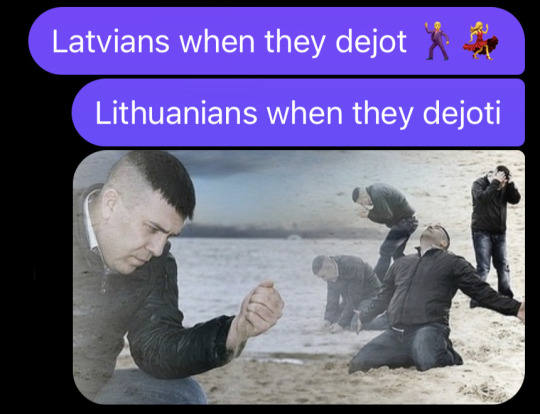#lithuanian langblr
Text
I no longer show up as a listed blog under the #lithuanian langblr tag... it's empty... as someone who's trying to make another effort at formulating a study routine, that really hurts honestly
#it really feels like being told 'fuck you. all your past attempts failed so you should just give up now.'#I know that's just how the algorithm works but the mental instability just magnifies it's negative significance tenfold#lithuanian langblr
17 notes
·
View notes
Text
Random Vocab List of My Target Languages
Note: I am still learning so if anyone has any corrections please say
English Korean French German Lithuanian
Snow 눈 la neige der Schnee Sniegas
Rain 비 la pluie der Regen Lietus
Clouds 구름 le nuage die Wolken Debesys
Sun 해 le soleil die Sonne Saulė
Moon 달 la lune der Mond Mėnulis
Angels 천사 l’ange die Engel Angelai
Memory 기억 la mémoire die Erinnerung Atsiminimas
Kiss 키스 le baiser der Kuss Bučinys (m)
Singing 노래 부르기 le chant der Gesang Dainavimas (m)
Day 하루 le jour der Tag Dienà
#vocabulary#french#korean#german#Lithuanian#langblr#vocab lists#French langblr#Korean langblr#German langblr#Lithuanian langblr
35 notes
·
View notes
Text


During my mini hiatus I fulfilled my dream of visiting Norway! The most surprising thing was hearing Lithuanian being spoken literally everywhere. My mum and I always speak Lithuanian to each other, so it was incredibly bizarre for people to overhear us and then come speak with us, or to have waiters/shopkeepers switch from English to Lithuanian. I’ve never experienced anything like it before, and I had no idea so many Lithuanians live in Norway! I absolutely ADORED this, it made all the places we visited instantly feel like home. Despite all that, I learned a bit of Norwegian and discovered that it’s literally the cutest language. Language learning is absolutely wonderful
#But fr it made me so happy 🥺 I rarely ever get to use my lithuanian so this was such a pleasant surprise!!#When we arrived in Oslo we sat down at a restaurant and were discussing how ridiculously expensive everything was -#- and then the waitress came over and asked (in lithuanian) if we were ready to order 💀💀💀💀#We were struggling to find our hotel and we asked two ladies on a bench who were speaking lithuanian where we could find it !!#At a food festival in Bergen there was a stand for lithuanian chocolate so we were tasting there and had so many Lithuanians come and chat#And soooo many more instances like this !!#Imagine spending 99% of your time not speaking a language outside of the country / without your family#and then all of a sudden everyone speaks this language in the least expected place. Woah!#If I wasn’t so settled in France and if I was a bit less poor I would consider moving to Bergen. I loved itttt !!!!#studyblr#light academia#studyspo#langblr#norway#cottagecore
480 notes
·
View notes
Text
In Italian language, "chi", e.g. "chioma" is read like [kioma] and "ci", e.g. "cinta" is read like [cheenta].
In Lithuanian language, "ci" is read like in "Tsitsipas" and "chi/či" like in "cheesecake."
Anyway, our choir tried to sing the Italian national anthem for the first time, and 🤣🤣🤣 by the end, only 2 people were singing - the girl who's already been to Italy by Erasmus and me who watched Jojo Vento Aureo with subs.
You could have heard sobbing from different corners.
#Italian language#italy#italian langblr#Lithuanian language#Lithuania#Lithuanian langbr#linguistics#thanks god I also used to listen to Adriano Celentano as a kid#he saved my a$$
21 notes
·
View notes
Text
Languages with the most sounds
Languages have different phonetic inventories. Some languages use more sounds than others. Two sounds are different if they are perceived to constitute two distinct phonemes by native speakers.
Here is a ranking of the most common languages by the number of sounds (phonemes) they use. Diphthongs are not considered because they are merely a combination of vowels that already exist in a language.
Lithuanian: 12 vowels and 47 consonants = 59 sounds
Danish: 32 vowels and 20 consonants = 52 sounds
Hindustani: 11 vowels and 37 consonants = 48 sounds
Welsh: 14 vowels and 31 consonants = 45 sounds
German: 20 vowels and 25 consonants = 45 sounds
Belarusian: 6 vowels and 39 consonants = 45 sounds
Norwegian: 19 vowels and 25 consonants = 44 sounds
Irish: 11 vowels and 33 consonants = 44 sounds
Bulgarian: 8 vowels and 36 consonants = 44 sounds
Hungarian: 14 vowels and 27 consonants = 41 sounds
Ukrainian: 6 vowels and 34 consonants = 40 sounds
Russian: 6 vowels and 34 consonants = 40 sounds
Slovak: 10 vowels and 29 consonants = 39 sounds
Latvian: 12 vowels and 27 consonants = 39 sounds
French: 17 vowels and 22 consonants = 39 sounds
Estonian: 9 vowels and 30 consonants = 39 sounds
Dutch: 16 vowels and 23 consonants = 39 sounds
Icelandic: 16 vowels and 22 consonants = 38 sounds
Portuguese: 14 vowels and 23 consonants = 37 sounds
Polish: 6 vowels and 31 consonants = 37 sounds
Czech: 10 vowels and 27 consonants = 37 sounds
Albanian: 7 vowels and 30 consonants = 37 sounds
English: 12 vowels and 24 consonants = 36 sounds
Catalan: 8 vowels and 28 consonants = 36 sounds
Swedish: 17 vowels and 18 consonants = 35 sounds
Mandarin: 9 vowels and 26 consonants = 35 sounds
Finnish: 16 vowels and 18 consonants = 34 sounds
Arabic: 6 vowels and 28 consonants = 34 sounds
Hausa: 10 vowels and 24 consonants = 34 sounds
Esperanto: 5 vowels and 27 consonants = 32 sounds
Persian: 6 vowels and 26 consonants = 32 sounds
Turkish: 8 vowels and 23 consonants = 31 sounds
Serbo-Croatian: 5 vowels and 25 consonants = 30 sounds
Italian: 7 vowels and 23 consonants = 30 sounds
Basque: 6 vowels and consonants = 30 sounds
Romanian: 7 vowels and 22 consonants = 29 sounds
Galician: 7 vowels and 19 consonants = 26 sounds
Spanish: 5 vowels and 20 consonants = 25 sounds
Greek: 5 vowels and 18 consonants = 23 sounds
Japanese: 5 vowels and 17 consonants = 22 sounds
This is by no means a complete list and is also very Eurocentric, but the source only had information for these languages.
#langblr#spanish#english#french#german#catalan#russian#lithuanian#danish#welsh#belarusian#norwegian#irishgaelic#bulgarian#hungarian#ukrainian#estonian#dutch#icelandic#portuguese#polish#swedish#mandarin#finnish#lingblr#greek#arabic#esperanto
270 notes
·
View notes
Text
My teacher is apparently my teacher is very impressed with my skills to self-study Lithuanian, so now I only need to come to class when I want to and then we just sit and chat in Lithuanian.
It's great because talking to native speakers is super scary but I need practice but also very validating because I don't feel like I speak very impressive Lithuanian.
13 notes
·
View notes
Text

Discovered a fun false friend during Lithuanian class today
#dejot (lat.) = dance#dejoti (lit.) = lament#Lithuanian#Latvian#langblr#linguistics#latviešu#lietuvių kalba#latvia#lithuania
28 notes
·
View notes
Text
Does anyone here know Lithuanian?
6 notes
·
View notes
Text

Ilekroć z Prus powracam, chcąc zmyć się z niemczyzny,
Wpadam do Soplicowa jak w centrum polszczyzny;
Tam się człowiek napije, nadysze ojczyzny!
***
- Adam Mickiewicz, "Pan Tadeusz"
#ojczyzna#pan tadeusz#adam mickiewicz#mickiewicz#polska#polskie cytaty#cytaty po polsku#poland#polish#polish literature#polish langblr#romantyzm#polish romanticism#prusy#prussia#rzeczpospolita#Polish lithuanian commonwealth#dwór#dworek#polishcore
35 notes
·
View notes
Text
Lithuanian; Second Declension Nouns in the Singular
Feminine nouns ending in -a, -ė, and -i
With dienà (day), gãtvė (street), and martì (daughter-in-law)
Nominative: dienà gãtvė martì
Genitive: dienõs gãtvės marčiõs
Dative: diẽnai gãtvei marčiai
Accusative: diẽną gãtvę marčią
Illative: dienà gatvè marčià
Locative: dienojè gãtvėje marčiojè
Vocative: diẽna gãtve marti
note: the acute, grave, and circumflex symbols do not appear in the written language, and are placed here merely as intonation markers.
note: marčiai, marčia, and marti (dative, accusative, and vocative, respectively) should each receive a circumflex over the 'r'.
#Lithuanian#Lithuanian Language#singular nouns#second declension#language#langblr#languageblr#studyblr#grammar#linguistics
2 notes
·
View notes
Text

-----
this is the most seriously I've practiced writing in lithuanian in a long time. I'm proud of myself. there's probably glaring errors, and I def used a dictionary when I needed to, but I'm proud of what I've written.
this year has honestly been so bad, but I'm trying to set myself up for next year. I just want to be able to study lithuanian again.
I'm happy just maintaining german and japanese bc I'm already proficient, but studying lithuanian is something I love. I want to get better!
I want next year to be better than this year.
#ngl I know there are more than a few lithuanian speakers that follow me at this point and posting my own writing makes me feel a bit nervous#but that's good!!#labai ačiū už skaitėte ^_^#please interact!#lithuanian langblr#langblr#lietuvių kalba
9 notes
·
View notes
Text
Random Vocab List of My Target Languages
Note: I am still learning so if anyone has any corrections please say
English Korean French German Lithuanian
Spring 봄 le printemps der Frühling Pavasaris
Summer 여름 l’été der Sommer Vasara
Autumn 가을 l’automne der Herbst Ruduo
Winter 겨울 l’hiver der Winter Žiema
#vocabulary#french#korean#german#Lithuanian#langblr#my post#French vocabulary#Korean vocabulary#German vocabulary#Lithuanian vocabulary
16 notes
·
View notes
Text
Introduction Post
Pedo mellon a minno, welcome to my langblr blog!
This is a sideblog, my main is @goblincoreinfp.
I post langblr stuff about the languages I'm learning, and sometimes studyblr stuff in general.
Besides the languages I'm learning, languages of interest are: all languages, including conlangs and sign languages, but especially northern languages like Slavic, Nordic, Celtic ones, etc.
currently dabbling in: lithuanian bc of the hardcore hannigram brainrot
I created this blog to try and motivate myself to study. I'm glad you're here, have fun!
1 note
·
View note
Text
Wait, wait, wait...
So you know, the Lithuanian and Belaruthian coat of arms?


In Lithuanian, it is called "Vytis," which means "The Chaser/The Pursuer." In Belaruthian, it is called Pahonia/Pagonia, which means "chasing/pursuing/hunting". Equal to Ukrainian word "погоня".
Pagonis in Lithuanian means "a pagan".
9 notes
·
View notes
Photo









New Year, new plans!
I really hope I’ll be able to reach most of my goals in 2022, especially those about Turkish and French. Wish me luck!
I also want to be more active here and on ig. I want to start a studygram account to help me with being more disciplined and committed to language learning
The setup is inspired by a great post of @thestudyreckless on ig
#language plans#langblr#turkish langblr#french langblr#lithuanian langblr#yddish langblr#german langblr#russian langblr#my post#languagesandstuff#2022
12 notes
·
View notes
Note
i've heard that there's a chart with the different grammar tenses and genders in lithuanian? is there one from the internet you recommend?
Hi! I couldn't find a chart I would like, per se, so I just read some texts and summarized them here.
I did find some charts on tenses and I have added those in. The whole post is under the cut, because it's really, really long.
Genders. In Lithuanian there are two grammatical genders, feminine and masculine. We conjugate nouns and adjectives (numbers included) by gender. Adjectives are being fitted to nouns in sentences, and that means that most adjectives will have both gender forms (not all numbers do), so you won't have to memorize them! Both are good (just depend on the noun)!
Meanwhile, nouns can have only one gender or both, depending on the noun. A good rule of thumb is that if we are talking about an alive thing that can biologically have a gender - it will, and the grammatical gender will match it (simple examples would be animals, like katė for female cat and katinas for male). If we are talking about inanimate objects, it will, unfortunately, mean a lot of memorization.
Technically, you could try learning genders by relying on how a noun ends in nominative (-is, -as, -us, -uo for masculine and -a, -ė, -is for feminine), but this could be a slippery slope due to two facts: 1) there are endings that can be used by words of either gender (as in, the ending would not give you the gender, like -is, for example, we have both moteris (a woman, feminine) and šaltinis (a spring, masculine), and 2) there are words that end in -as and -a and could be used for both genders without changing the word (like nevala, someone who is dirty or doesn't clean up, can be used to address a person of either gender). The endings work pretty well for names, however, so at least reading the name you can technically tell the gender of the person (I am saying this from a language learner point of view, so please don't actually assume a persons gender). There are also other fun things about gender, like, a group of people consisting of only women will be addressed with a feminine word, but if there is at least one man in the group (even if it's 1 in 100), the group will be addressed with a masculine word (studentai can mean both male students and a group of students of different genders).
If you can read Lithuanian, I would suggest checking these links out (they are kind of hard to read for a beginner, I admit):
• here
• here
• and here (edit: tumblr apparently won't let me add links to pdf files, so if you can read Lithuanian and would like the links, hit me up)
The last link also has loads of other info, including all parts of speech and conjugation in general. It also has info on verbs, and with that lets move to tenses that could easily have their own separate post (or rather, a series of post, so this is going to be brief).
Tenses. To put it simply, in Lithuanian, there are two groups of verbs, the main group (infinitive, present tense 3rd person, past simple tense 3rd person) and all the others, that can be made using the main ones. So if you learn these main three forms of verbs, other forms will be like conjugations for you. As for what tenses we have, in general, I found a chart:

.there are some fancy words in here, but what you need to know is that there is a present tense (1), a future tense (1) and past tenses (2). Infinitive is technically not a tense, so it's not mentioned in the chart. Past tenses are divided into two, which in Lithuanian we call būtasis kartinis (past simple, for things that happened one time (kartą → kartinis) or maybe an unknown number of times) and būtasis dažninis (for things that we know for sure have happened more than once in the past, frequency (dažnis → dažninis)). That's it, only four tenses (+ infinitive)! Sure, we can and do make conditional sentences (if I had gone straight to bed after dinner, I wouldn't have felt so exhausted in the morning → jei būčiau nuėjęs miegoti iškart po vakarienės, nebūčiau toks pavargęs ryte) in Lithuanian, but they use participles and moods, and we are not getting into that on this post.
Now, about every tense a bit.
Present: can be used to mean what is happening in the present (aš rašau - I am writing) and things that are happening and they are taking some time or maybe are happening forever (upė teka - river runs/is running).
Past "simple" (būtasis kartinis): used for talking about things that have happened once, or have happened with no specifics, or the specifics make it clear that this was a thing that has happened a specific amount of times (aš ėjau namo - I walked home; aš tris kartus dalyvavau maratone - I participated in the marathon three times).
Repeated Past (būtasis dažninis): used for things that used to happen, multiple times, but are not happening anymore (vasaromis aš grybaudavau miške - in summertime I used to pick mushrooms). Making of this tense is relatively easy, it's just adding -dav- to a simple past (nešė - nešdavo - carried , bėgo - bėgdavo - ran).
Future "simple": used for talking about future (aš važiuosiu į mokyklą - I will drive/be driving to school), for negative expressions when we mean the opposite of what we mean (žinau, kaipgi nežinosi! - I know, how could I not (know)!) and sometimes when we don't mean any time at all (ėjau namo, ir kad pradės lyti, net skėčio išsitraukti nespėjau - I was walking home and it just started to rain so suddenly that I didn't even pull out my umbrella in time).
As I have mentioned in the beginning of the paragraph about tenses, to make other tenses, one just needs to know the main trio, and here is another picture to illustrate them:

The way these verbs are conjugated depend on the 3rd person (jis, ji, jie, jos) and if you learn the endings for example for the group that ends with -a in 3rd person, all verbs that end with -a in 3rd person will have the same endings in other persons, accordingly.
Sorry, this got lengthy, but hopefully it will be useful(?).
#langblr#lithuanian langblr#lithuanian language#lithuanian#;answered#language; lt#this took me a couple of hours to write damn I really got into it huh#I keep thinking about a chart and maybe I could make one but it's like have past midnight here so decidedly not today
15 notes
·
View notes